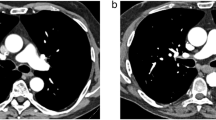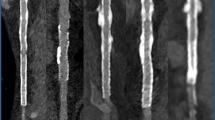Abstract
Background
The rubidium 81/krypton 81m method was suggested for assessment of myocardial blood flow (MBF) three decades ago. This study investigates the novel concept of using 81Rb-/81mKr-labeled coronary guide wires with wire-attached 81Rb activity and diffusable 81mKr gas for assessment of lesion-specific impairment of MBF by evaluation of the 81Rb/81mKr activity ratio. The feasibility of wire production is tested, and application of the method is investigated in the canine model.
Methods and Results
Conventional coronary guide wires for angioplasty (0.014 in) were labeled with radioactive 81Rb/81mKr by ion bombardment of the wire tip. A total of 16 of the 18 wires labeled in series showed successful 81Rb fixation in combination with free 81mKr gas diffusability during quality control measurements. The suitability of the wires to assess MBF in combination with an external gamma ray detector was investigated in open-chested dogs. Electromagnetic measurement of coronary blood flow (CBF) was used as reference, providing a signal that is directly linked to volumetric MBF. The 81Rb/81mKr ratio tracked changes in CBF reliably in all 6 dogs. The found linear dependence of measured 81Rb/81mKr count rates on measured CBF supports the modeling assumptions made to apply the theoretic basis of the 81Rb/81mKr technique to 81Rb-labeled coronary guide wires.
Conclusion
81Rb-/81mKr-labeled coronary guide wires provide a signal that indicates volumetric MBF directly. This unique capability may qualify the technique as a valuable tool for research purposes and as an attractive method for invasive cardiology at centers where the logistic arrangements for short-lived isotope supply are provided.
Similar content being viewed by others
References
Deychak YA, Segal J, Reiner JS, Nachnani S. Doppler guide-wire-derived coronary flow reserve distal to intermediate stenoses used in clinical decision making regarding interventional therapy. Am Heart J 1994;128:178–81.
Pijls NH, De-Bruyne B, Peels K, Van-Der-Voort PH, Bonnier HJ, Bartunek J, et al. Measurement of fractional flow reserve to assess the functional severity of coronary artery stenoses. N Engl J Med 1996;334:1703–8.
Jones T, Matthews CM. Tissue perfusion measured using the ratio of 81Rb to 81mKr incorporated in the tissue. Nature 1971;230:119–20.
Spencer RP, Hosain F. Theoretical basis for regional blood flow measurement by use of the ratio of 81Rb: 81mKr. Int J Nucl Med Biol 1975;3:55–6.
Martin ND, Zaret BL, McGowan RL, Wells HP, Flamm MD. Rubidium-81: a new myocardial scanning agent. Radiology 1974;111:651–6.
Idoine JD, Holman BL, Jones AG, Schneider RJ, Schroeder KL, Zimmerman R. Quantification of flow in a dynamic phantom using 81Rb-81mKr and a NaJ detector. J Nucl Med 1977;18:570–8.
Stoll HP, Bay W, Vogel W, Özbek C, Hanser A, Schieffer H, et al. Myocardial perfusion measured by dual-isotope acquisition of 81rubidium/81mkrypton: an experimental verification of the method. Basic Res Cardiol 1994;89:354–65.
Beyer GJ, Ravn HL. A 81Rb/81mKr generator made by ion implantation. Int J Radiat Appl Instrum (A) 1991;42:141–2.
Hanser A, Feurer B. Pure 81Rb for medical use obtained by electromagnetic isotope separation. Int J Appl Radiated Isot 1981;32: 775–8.
Hanser A. Routine production of high purity 81Rb by means of electromagnetic isotope separation. Int J Radiated Appl Instrum (A) 1989;40:309–14.
Gonschior P, Gonschior GM, Conzen PF, Hobbhahn J, Goetz AE, Peter K. Myocardial oxygenation and transmural lactate metabolism during experimental acute coronary stenosis in pigs. Basic Res Cardiol 1992;87:27–37.
Stubbs JB, Evans JF, Stabin MG. Radiation absorbed doses to the walls of hollow organs. J Nucl Med 1998;39:1989–95.
International Commission on Radiological Protection. ICRP publication 38: radionuclide transformations: energy and intensity of emission. New York: Elsevier; 1983.
Levèfre T, Bernard A, Bertrand M, Lablance JM, Cequier A, Espuglas E, et al. Comparaison en microscopie électronique du potentiel antithrombogène de deux produits de contraste iodés de basse osmolalité au cours de l'angioplastie coronaire transluminal percutanée. Arch Mal Coeur Vaiss 1994;87:225–33.
Müller M, Oberhausen E, Stoll HP, Schmidt EL, Hanser A, Vogel W. 81-Rubidium/81m-Krypton SPECT-untersuchungen zur beurteilung hochgradiger koronarstenosen. Herz/Kreislauf 1986;3:128–33.
Zimmermann R, Tillmanns H, Bubek B, Neumann FJ, Ernst A, Bihl H, et al. Non-invasive detection of reduced myocardial perfusion at rest in patients with unstable angina pectoris: increased regional 81mKr deposition following intravenous injection of 81Rb. Nuklearmedizin 1991;30:125–31.
Author information
Authors and Affiliations
Rights and permissions
About this article
Cite this article
Stoll, HP., Huwer, H., Vollmar, B. et al. Experimental validation of a new coronary guide wire labeled with rubidium 81/krypton 81m for continuous assessment of myocardial blood flow. J Nucl Cardiol 7, 255–262 (2000). https://doi.org/10.1016/S1071-3581(00)80014-8
Issue Date:
DOI: https://doi.org/10.1016/S1071-3581(00)80014-8




